Prospective Powering Strategy Development for Intelligent-Tire Sensor Power Charger Application
Abstract
:1. Introduction
2. Materials and Methods
2.1. The Generic Intelligence-Tire System Architecture
2.2. The Proposed Tire Sensor Powering Strategy Concept
2.3. WPT Technology
2.4. The Proposed Tire Sensor Powering Strategy Architecture
2.5. The Proposed Powering Strategy Concept Verification Method
3. Proposed Powering Strategy Verification
3.1. Model Configuration
3.2. Method and Experiment
4. Result and Discussion
5. Conclusions
Author Contributions
Funding
Data Availability Statement
Acknowledgments
Conflicts of Interest
References
- Schulze, T.; Müller, B.; Meyer, G. Advanced Microsystems for Automotive Applications 2016: Smart Systems for the Automobile of the Future; Springer: Berlin/Heidelberg, Germany; New York, NY, USA, 2016; ISBN 9783319447650. [Google Scholar]
- Ray, S.; Chen, W.; Bhadra, J.; Al Faruque, M.A. Extensibility in Automotive Security: Current Practice and Challenges: Invited. In Proceedings of the 54th Annual Design Automation Conference 2017, Austin, TX, USA, 18–22 June 2017; ACM: New York, NY, USA, 2017; pp. 1–6. [Google Scholar]
- Peden, M.M. World Report on Road Traffic Injury Prevention; World Health Organization: Geneva, Switzerland, 2004; ISBN 9789241562607. [Google Scholar]
- Keck, M. A New Approach of a Piezoelectric Vibration-Based Power Generator to Supply next Generation Tire Sensor Systems. In Proceedings of the 2007 IEEE Sensors, Atlanta, GA, USA, 28–32 October 2007; pp. 1299–1302. [Google Scholar] [CrossRef]
- Chen, Y.-Y.; Pan, H.-W. A Piezoelectric Vibration Energy Harvester for Tire Pressure Monitoring Systems. In Proceedings of the Symposium on Ultrasonic Electronics, Kyoto, Japan, 8–10 November 2011; Volume 32, pp. 321–322. [Google Scholar]
- Zheng, Q.; Tu, H.; Agee, A.; Xu, Y. Vibration Energy Harvesting Device Based on Asymmetric Air-Spaced Cantilevers for Tire Pressure Monitoring System. In Proceedings of the the Power MEMS 2009, Washington, DC, USA, 1–4 December 2009; pp. 403–406. [Google Scholar]
- Hatipoglu, G.; Urey, H. FR4-Based Electromagnetic Energy Harvester for Wireless Tyre Sensor Nodes. Procedia Chem. 2009, 1, 1211–1214. [Google Scholar] [CrossRef]
- Manla, G.; White, N.M.; Tudor, J. Harvesting Energy from Vehicle Wheels. In Proceedings of the Solid-State Sensors, Actuators and Microsystems Conference, Denver, CO, USA, 21–25 June 2009; pp. 1389–1392. [Google Scholar]
- Tang, Q.C.; Xia, X.Y.; Li, X.X. Non-Contact Frequency-up-Conversion Energy Harvester for Durable & Broad-Band Automotive TPMS Application. In Proceedings of the 2012 IEEE 25th International Conference on Micro Electro Mechanical Systems (MEMS), Paris, France, 29 January–2 February 2012; pp. 1273–1276. [Google Scholar] [CrossRef]
- Tornincasa, S.; Repetto, M.; Bonisoli, E.; Di Monaco, F. Energy Harvester for Vehicle Tires: Nonlinear Dynamics and Experimental Outcomes. J. Intell. Mater. Syst. Struct. 2012, 23, 3–13. [Google Scholar] [CrossRef]
- Frey, A.; Seidel, J.; Schreiter, M.; Kuehne, I. Piezoelectric MEMS Energy Harvesting Module Based on Non-Resonant Excitation. In Proceedings of the 2011 16th International Solid-State Sensors, Actuators and Microsystems Conference, Beijing, China, 5–9 June 2011; pp. 683–686. [Google Scholar] [CrossRef]
- Hu, Y.; Xu, C.; Zhang, Y.; Lin, L.; Snyder, R.L.; Wang, Z.L. A Nanogenerator for Energy Harvesting from a Rotating Tire and Its Application as a Self-Powered Pressure/Speed Sensor. Adv. Mater. 2011, 23, 4068–4071. [Google Scholar] [CrossRef]
- Gu, L.; Livermore, C. Pendulum-Driven Passive Self-Tuning Energy Harvester for Rotating Applications. In Proceedings of the PowerMEMS workshop, Leuven, Belgium, 30 November–3 December 2010. [Google Scholar]
- Pinna, L. Vibration-Based Energy Scavenging for Power Autonomous Wireless Sensor Systems. Ph.D. Thesis, University of Genoa, Genoa, Italy, February 2010; p. 141. [Google Scholar]
- Corti, F.; Reatti, A.; Nepote, A.; Pugi, L.; Pierini, M.; Paolucci, L.; Grasso, F.; Grasso, E.; Nienhause, M. A Secondary-Side Controlled Electric Vehicle Wireless Charger. Energies 2020, 13, 6527. [Google Scholar] [CrossRef]
- Wu, H.H.; Gilchrist, A.; Sealy, K.D.; Bronson, D. A High Efficiency 5 kW Inductive Charger for EVs Using Dual Side Control. IEEE Trans. Ind. Inform. 2012, 8, 585–595. [Google Scholar] [CrossRef] [Green Version]
- Zheng, C.; Lai, J.-S.; Chen, R.; Faraci, W.E.; Zahid, Z.U.; Gu, B.; Zhang, L.; Lisi, G.; Anderson, D. High-Efficiency Contactless Power Transfer System for Electric Vehicle Battery Charging Application. IEEE J. Emerg. Sel. Top. Power Electron. 2015, 3, 65–74. [Google Scholar] [CrossRef]
- Corti, F.; Grasso, F.; Paolucci, L.; Pugi, L.; Luchetti, L. Circular Coil for EV Wireless Charging Design and Optimization Considering Ferrite Saturation. In Proceedings of the 2019 IEEE 5th International forum on Research and Technology for Society and Industry (RTSI), Florence, Italy, 9–12 September 2019. [Google Scholar]
- Choi, S.Y.; Gu, B.W.; Jeong, S.Y.; Rim, C.T. Advances in Wireless Power Transfer Sys-tems for Roadway-Powered Electric Vehicles. IEEE J. Emerg. Sel. Top. Power Electron. 2015, 3, 18–36. [Google Scholar] [CrossRef]
- Throngnumchai, K.; Hanamura, A.; Naruse, Y.; Takeda, K. Design and evaluation of a wireless power transfer system with road embedded transmitter coils for dynamic charging of electric vehicles. In Proceedings of the 2013 World Electric Vehicle Symposium and Exhibition (EVS27), Barcelona, Spain, 17–20 November 2013; pp. 1–10. [Google Scholar] [CrossRef] [Green Version]
- Rozman, M.; Ikpehai, A.; Adebisi, B.; Rabie, K.; Gacanin, H.; Ji, H.; Fernando, M. Smart Wireless Power Transmission System for Autonomous EV Charging. IEEE Access 2019, 7, 112240–112248. [Google Scholar] [CrossRef]
- Chittoor, P.K.; Chokkalingam, B.; Mihet-Popa, L. A Review on UAV Wireless Charging: Fundamentals, Applications, Charging Techniques and Standards. IEEE Access 2021, 9, 69235–69266. [Google Scholar] [CrossRef]
- Rohan, A.; Rabah, M.; Talha, M.; Kim, S.-H. Development of intelligent drone battery charging system based on wireless power transmission using hill climbing algorithm. Appl. Syst. Innov. 2018, 1, 44. [Google Scholar] [CrossRef] [Green Version]
- Junaid, A.B.; Lee, Y.; Kim, Y. Design and implementation of autonomous wireless charging station for rotary-wing UAVs. Aerosp. Sci. Technol. 2016, 54, 253–266. [Google Scholar] [CrossRef]
- Yan, Y.; Shi, W.; Zhang, X. Design of UAV wireless power transmission system based on coupling coil structure optimization. EURASIP J. Wireless Commun. Netw. 2020, 1, 1–13. [Google Scholar] [CrossRef]
- Campi, T.; Cruciani, S.; Feliziani, M. Wireless power transfer technology applied to an autonomous electric UAV with a small secondary coil. Energies 2018, 11, 352. [Google Scholar] [CrossRef] [Green Version]
- APPOLO. Intelligent Tyre Systems-State of the Art and Potential Technologies; Technical Research Centre of Finland (VTT): Espoo, Finland, 2003. [Google Scholar]
- Singh, K.B.; Arat, M.A.; Taheri, S. Development of a Smart Tire System and Its Use in Improving the Performance of a Collision Mitigation Braking System. In Proceedings of the Volume 11: Transportation Systems, Houston, TX, USA, 9–15 November 2012; pp. 77–87. [Google Scholar]
- Jo, H.Y.; Yeom, M.; Lee, J.; Park, K.; Oh, J. Development of Intelligent Tire System; SAE Technical Paper; SAE: Warrendale, PA, USA, 8 April 2013. [Google Scholar]
- Amar, A.; Kouki, A.; Cao, H. Power Approaches for Implantable Medical Devices. Sensors 2015, 15, 28889–28914. [Google Scholar] [CrossRef] [PubMed]
- Luo, W.-J.; Kuncoro, C.B.D.; Pratikto; Kuan, Y.-D. Single-Layer Transmitter Array Coil Pattern Evaluation toward a Uniform Vertical Magnetic Field Distribution. Energies 2019, 12, 4157. [Google Scholar] [CrossRef] [Green Version]
- Hayt, W.H.; Buck, J.A. Engineering Electromagnetics, 8th ed.; McGraw-Hill: New York, NY, USA, 2012; ISBN 9780073380667. [Google Scholar]
- Wei, X.C.; Li, E.P.; Guan, Y.L.; Chong, Y.H. Simulation and Experimental Comparison of Different Coupling Mechanisms for the Wireless Electricity Transfer. J. Electromagn. Waves Appl. 2009, 23, 925–934. [Google Scholar] [CrossRef]
- Mendes Duarte, R.; Klaric Felic, G. Analysis of the Coupling Coefficient in Inductive Energy Transfer Systems. Act. Passiv. Electron. Compon. 2014, 2014, 1–6. [Google Scholar] [CrossRef] [Green Version]
- Karalis, A.; Joannopoulos, J.D.; Soljačić, M. Efficient Wireless Non-Radiative Mid-Range Energy Transfer. Ann. Phys. 2008, 323, 34–48. [Google Scholar] [CrossRef] [Green Version]
- Diab, Y.; Venet, P.; Gualous, H.; Rojat, G. Self-Discharge Characterization and Modeling of Electrochemical Capacitor Used for Power Electronics Applications. IEEE Trans. Power Electron. 2009, 24, 510–517. [Google Scholar] [CrossRef]
- Simjee, F.I.; Chou, P.H. Efficient Charging of Supercapacitors for Extended Lifetime of Wireless Sensor Nodes. IEEE Trans. Power Electron. 2008, 23, 1526–1536. [Google Scholar] [CrossRef]
- Luo, W.-J.; Kuncoro, C.B.D.; Kuan, Y.-D. Wireless Power Hanger Pad for Portable Wireless Audio Device Power Charger Application. Energies 2020, 13, 419. [Google Scholar] [CrossRef] [Green Version]
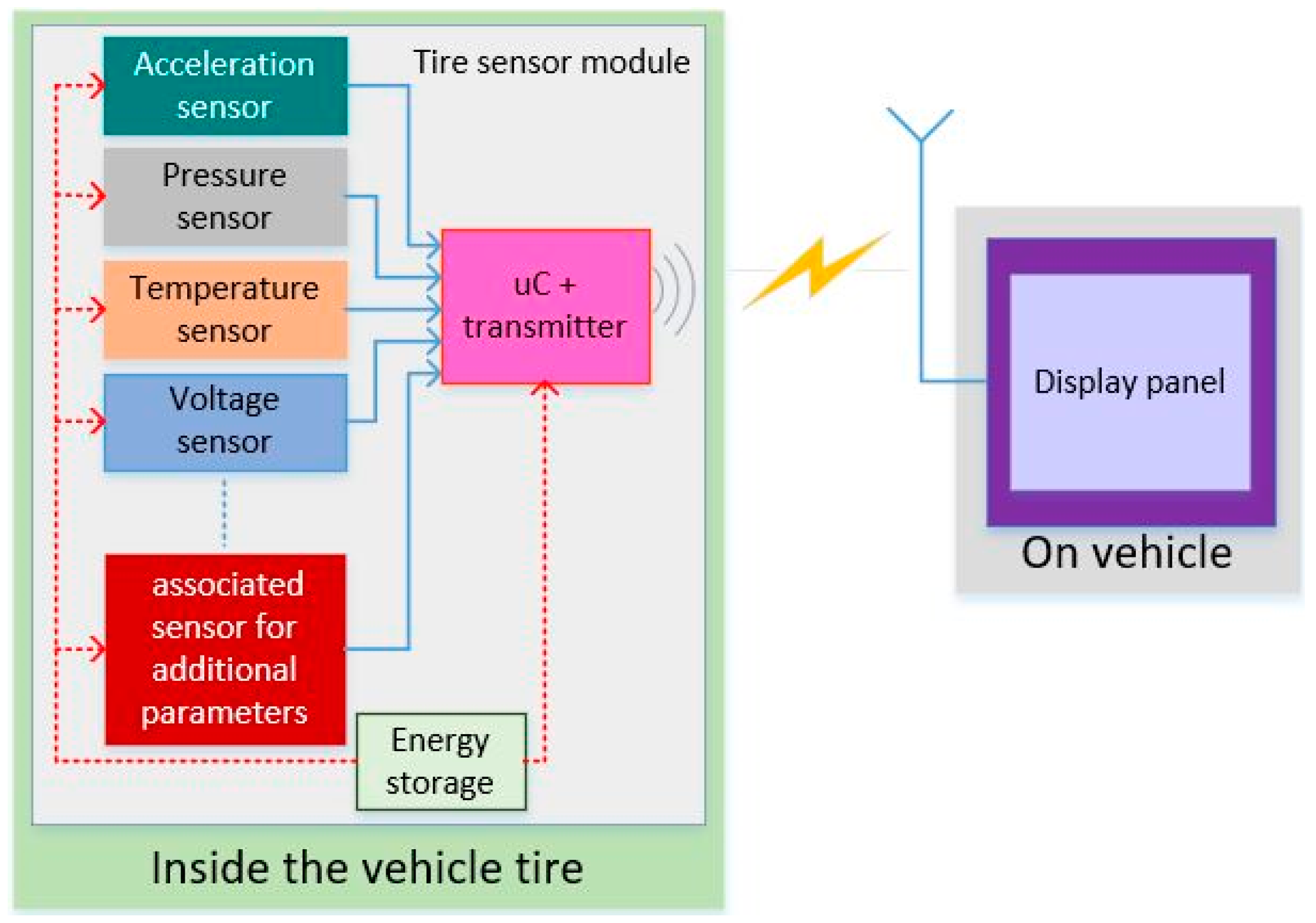
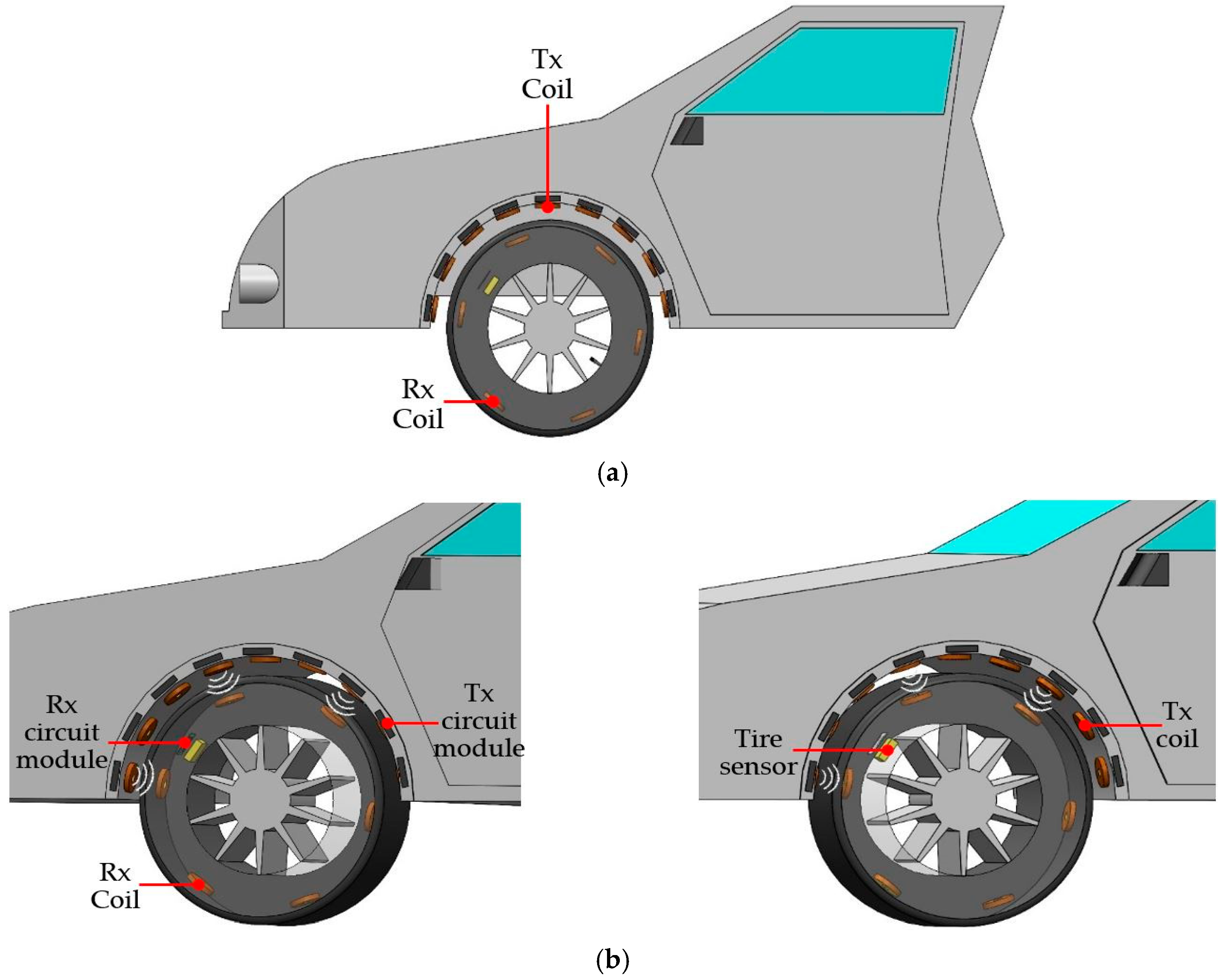
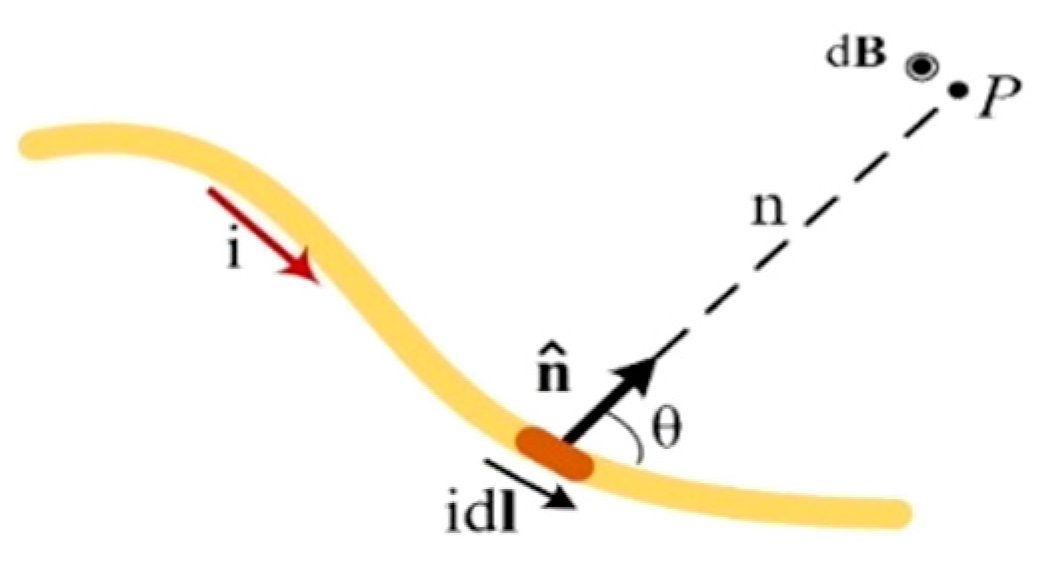
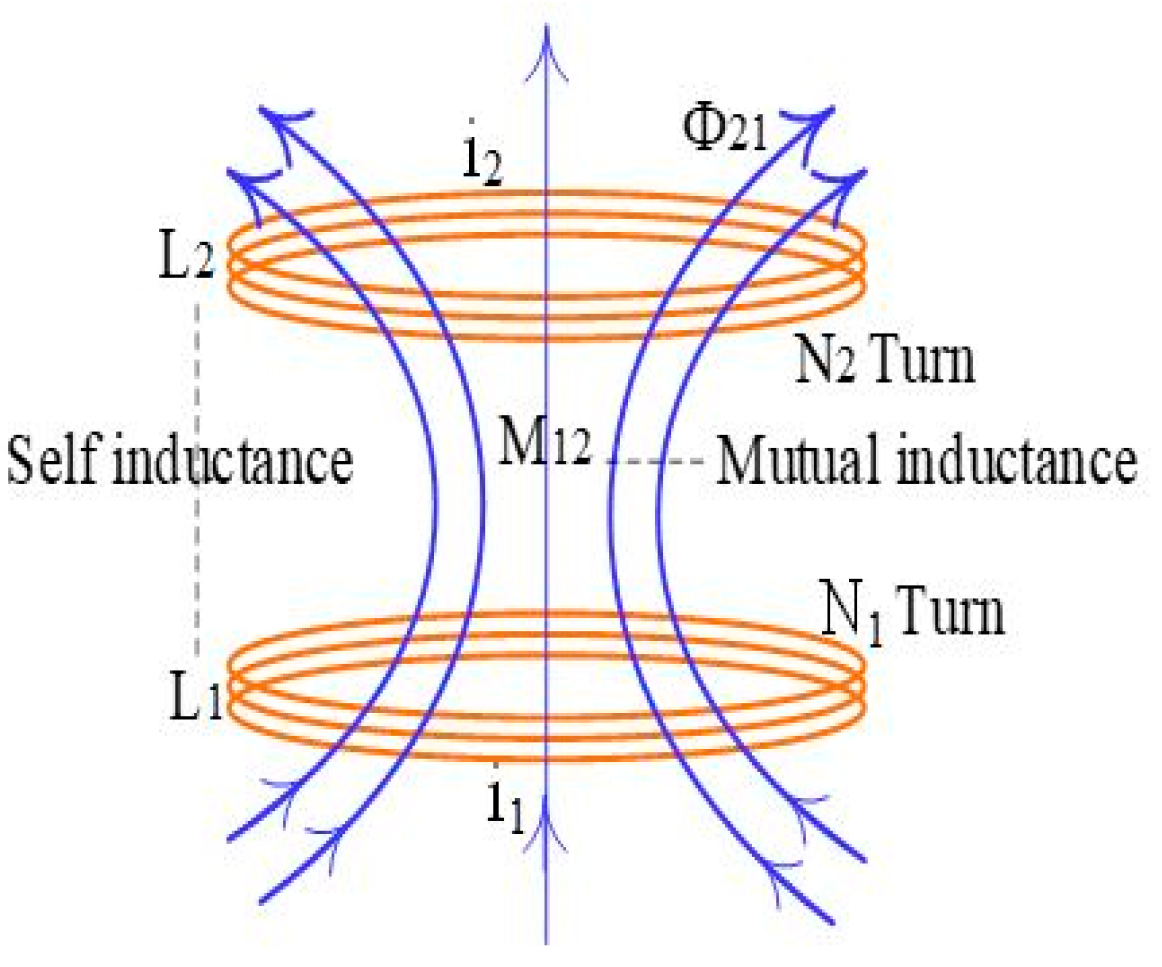
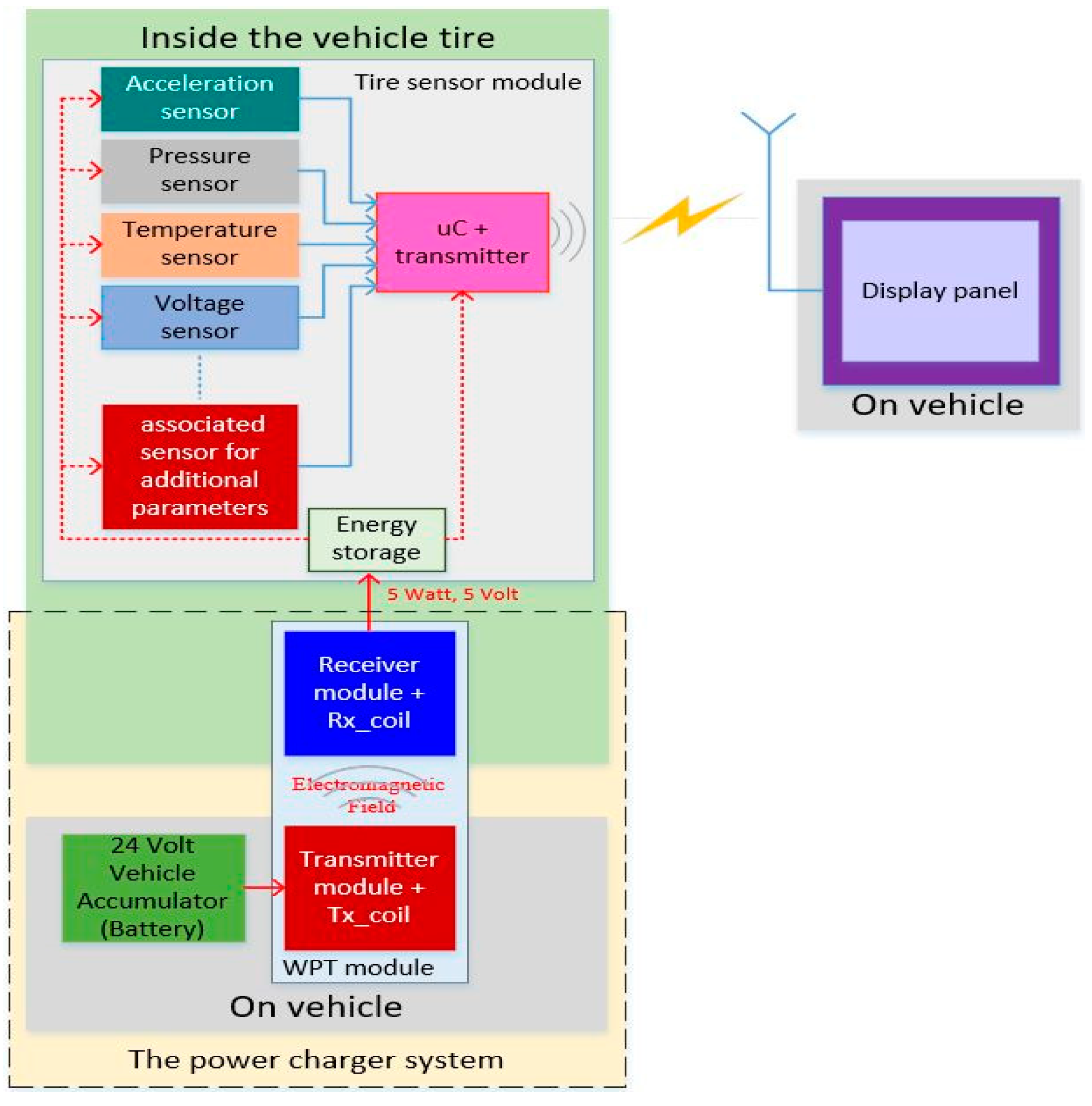
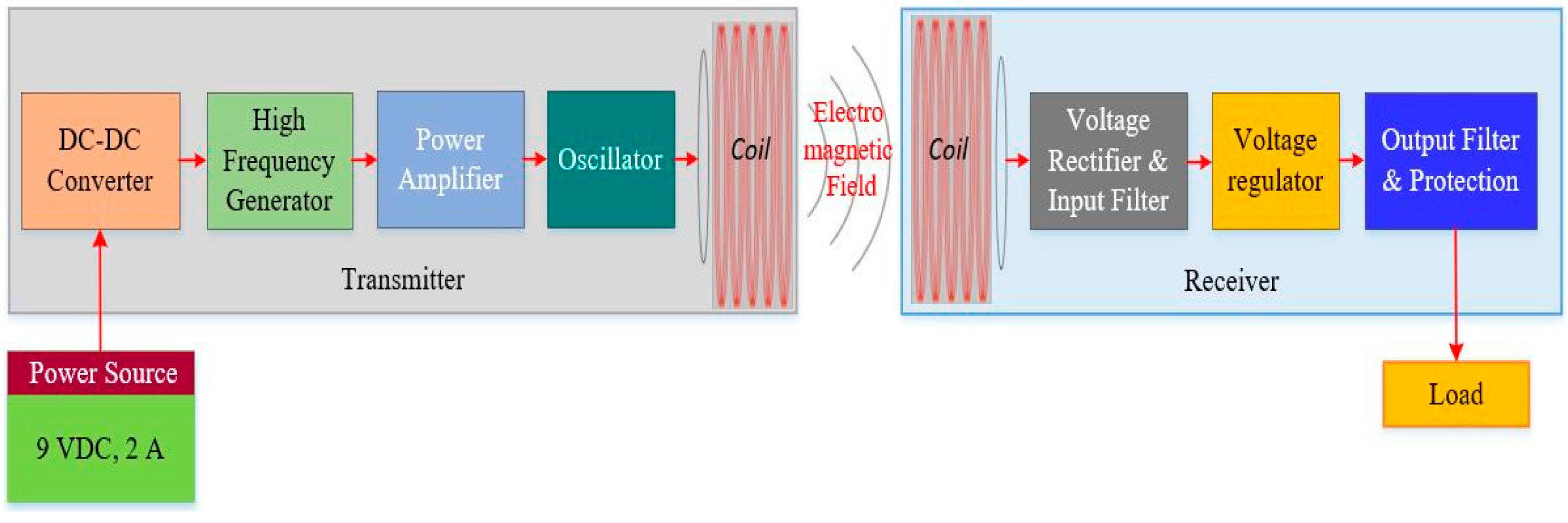




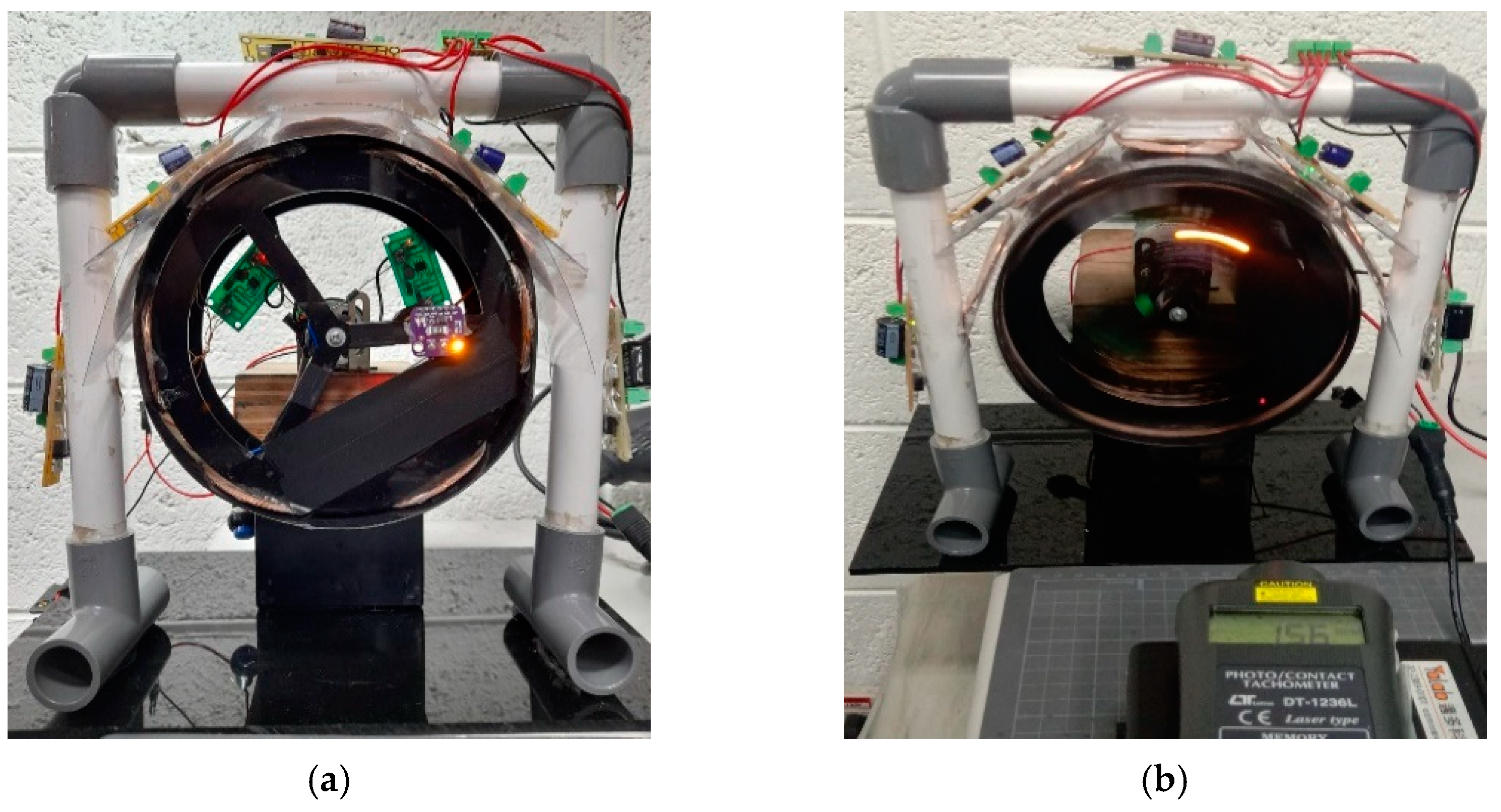
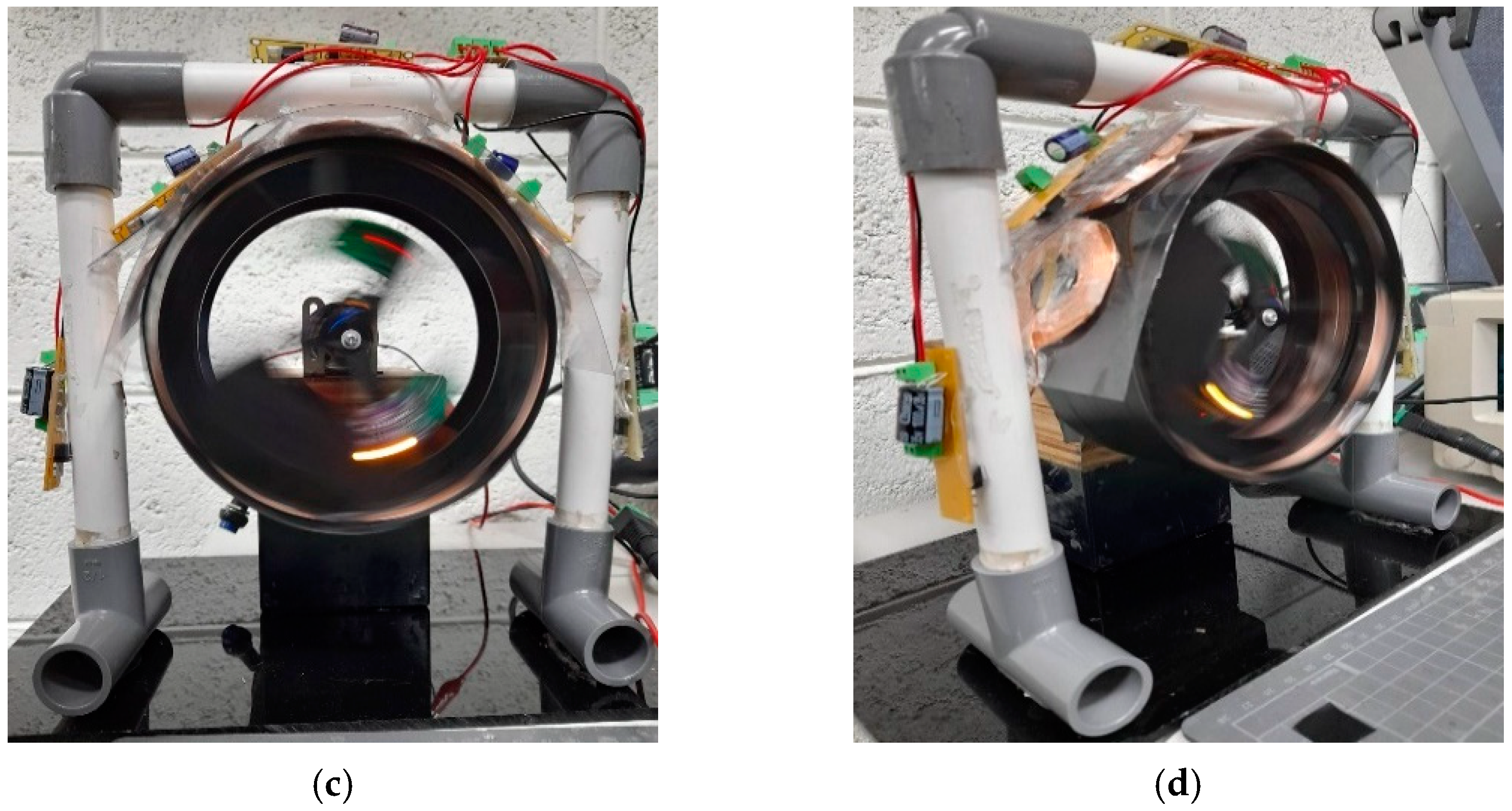
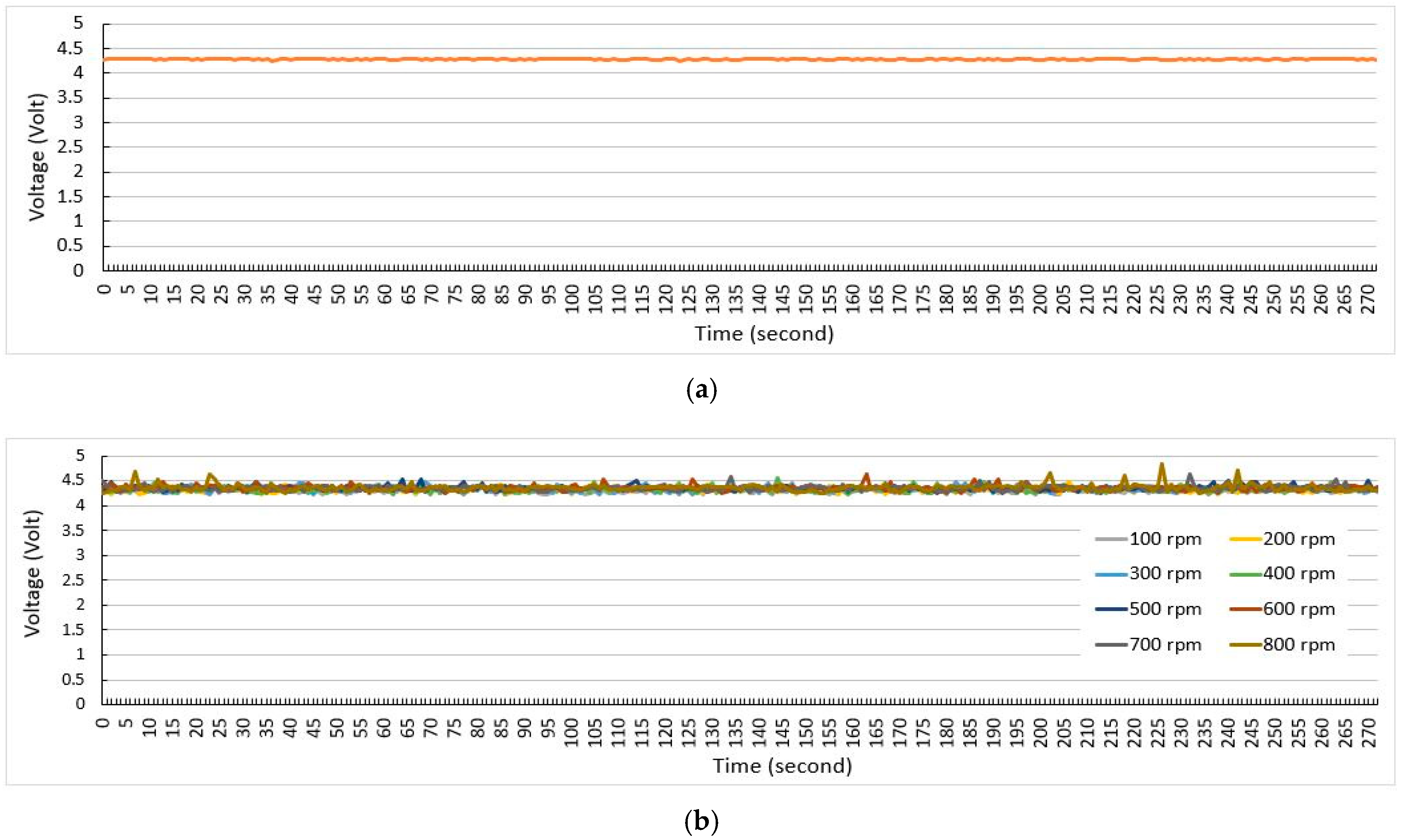



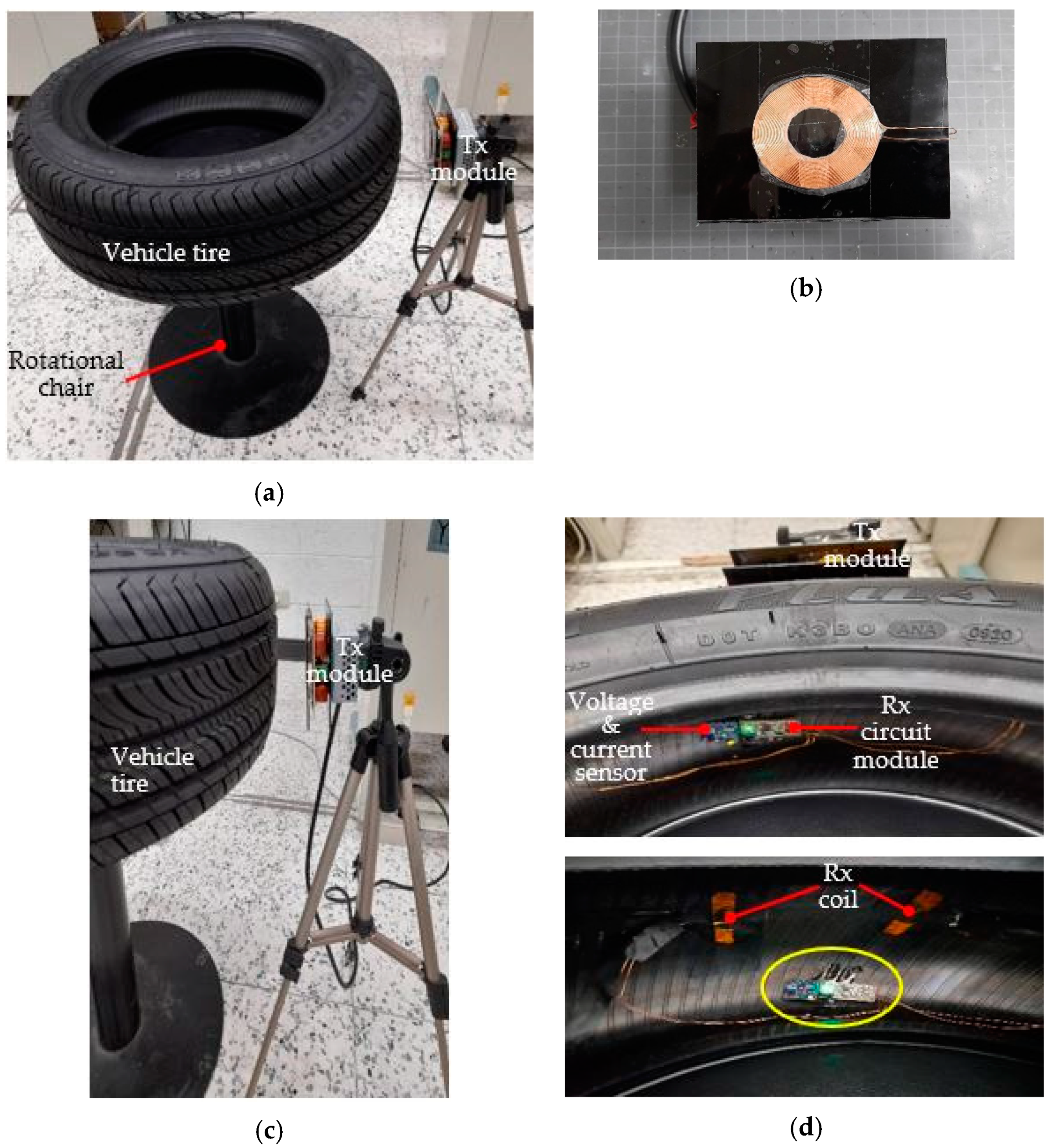
| Parameter | Description | Value |
|---|---|---|
| Coil geometry | circular flat spiral air core coil | - |
| Transmission method Rx module topology | electromagnetic induction full-wave rectifier | - |
| f | operating frequency | 110 kHz |
| DiTx | inner diameter of Tx coil | 25 mm |
| DoTx | outer diameter of Tx coil | 47.89 mm |
| DiRx | inner diameter of Rx coil | 25 mm |
| DoRx LTx | outer diameter of Rx coil Tx coil inductance | 47.89 mm 13.7 µH |
| LRx d ɳ | Rx coil inductance maximum transmission distance peak efficiency | 13.7 µH 2 cm 70% |
| W V I | maximum power delivery Rx module output voltage Rx module maximum output current | 5 W 5 V 1 A |
| No | Rotation Speed (rpm) | Time Duration (s) | Time Step (s) |
|---|---|---|---|
| 1 | 0 | 280 | 1 |
| 2 | 100 | 280 | 1 |
| 3 | 200 | 280 | 1 |
| 4 | 300 | 280 | 1 |
| 5 | 400 | 280 | 1 |
| 6 | 500 | 280 | 1 |
| 7 | 600 | 280 | 1 |
| 8 | 700 | 280 | 1 |
| 9 | 800 | 280 | 1 |
| No | Rotation Speed (rpm) | Average Voltage (V) |
|---|---|---|
| 1 | 100 | 4.32 |
| 2 | 200 | 4.33 |
| 3 | 300 | 4.33 |
| 4 | 400 | 4.33 |
| 5 | 500 | 4.35 |
| 6 | 600 | 4.35 |
| 7 | 700 | 4.35 |
| 8 | 800 | 4.36 |
| No | Rotation Speed (rpm) | Average Current (mA) |
|---|---|---|
| 1 | 100 | 21.03 |
| 2 | 200 | 21.08 |
| 3 | 300 | 21.12 |
| 4 | 400 | 21.15 |
| 5 | 500 | 21.04 |
| 6 | 600 | 21.19 |
| 7 | 700 | 21.18 |
| 8 | 800 | 21.36 |
Publisher’s Note: MDPI stays neutral with regard to jurisdictional claims in published maps and institutional affiliations. |
© 2021 by the authors. Licensee MDPI, Basel, Switzerland. This article is an open access article distributed under the terms and conditions of the Creative Commons Attribution (CC BY) license (https://creativecommons.org/licenses/by/4.0/).
Share and Cite
Kuncoro, C.B.D.; Sung, M.-F.; Adristi, C.; Permana, A.F.; Kuan, Y.-D. Prospective Powering Strategy Development for Intelligent-Tire Sensor Power Charger Application. Electronics 2021, 10, 1424. https://doi.org/10.3390/electronics10121424
Kuncoro CBD, Sung M-F, Adristi C, Permana AF, Kuan Y-D. Prospective Powering Strategy Development for Intelligent-Tire Sensor Power Charger Application. Electronics. 2021; 10(12):1424. https://doi.org/10.3390/electronics10121424
Chicago/Turabian StyleKuncoro, C. Bambang Dwi, Min-Feng Sung, Cornelia Adristi, Arvanida Feizal Permana, and Yean-Der Kuan. 2021. "Prospective Powering Strategy Development for Intelligent-Tire Sensor Power Charger Application" Electronics 10, no. 12: 1424. https://doi.org/10.3390/electronics10121424






